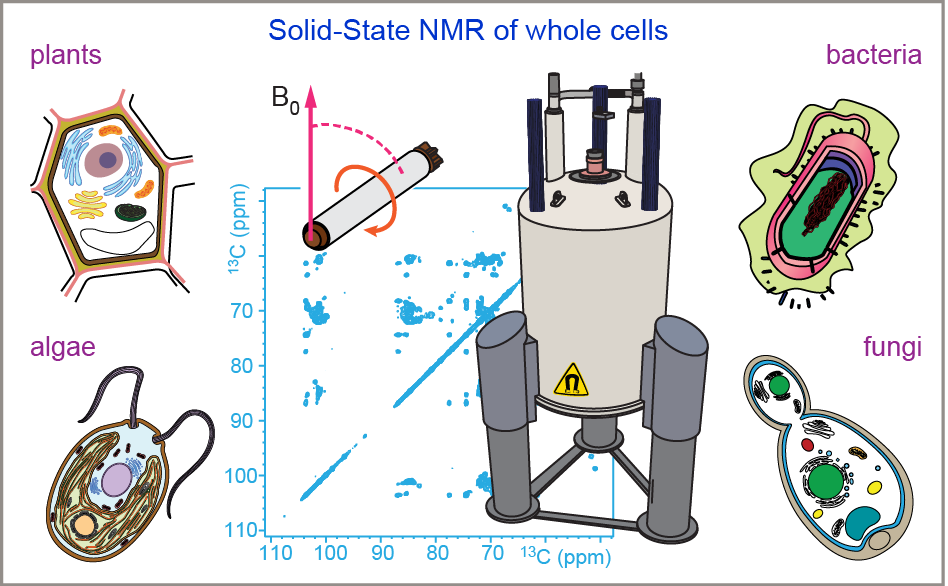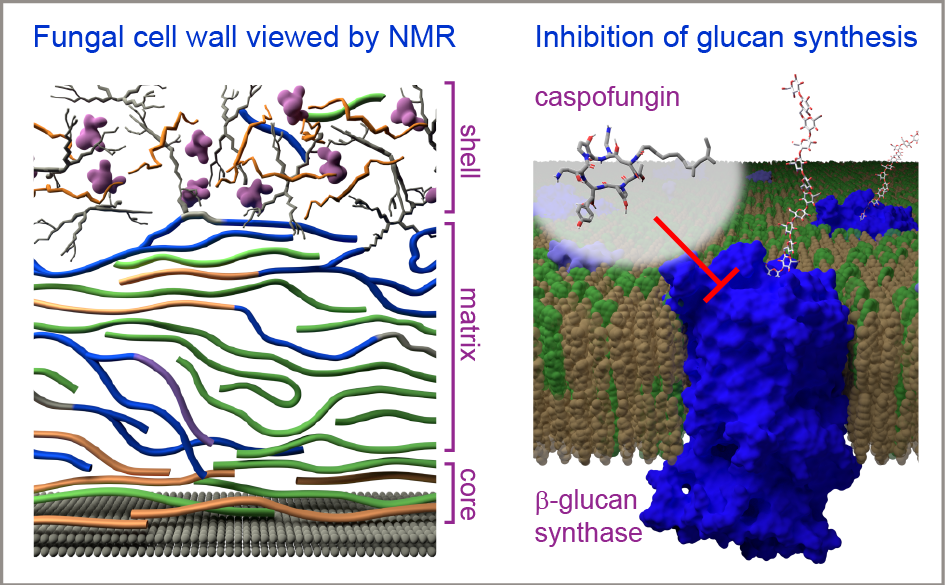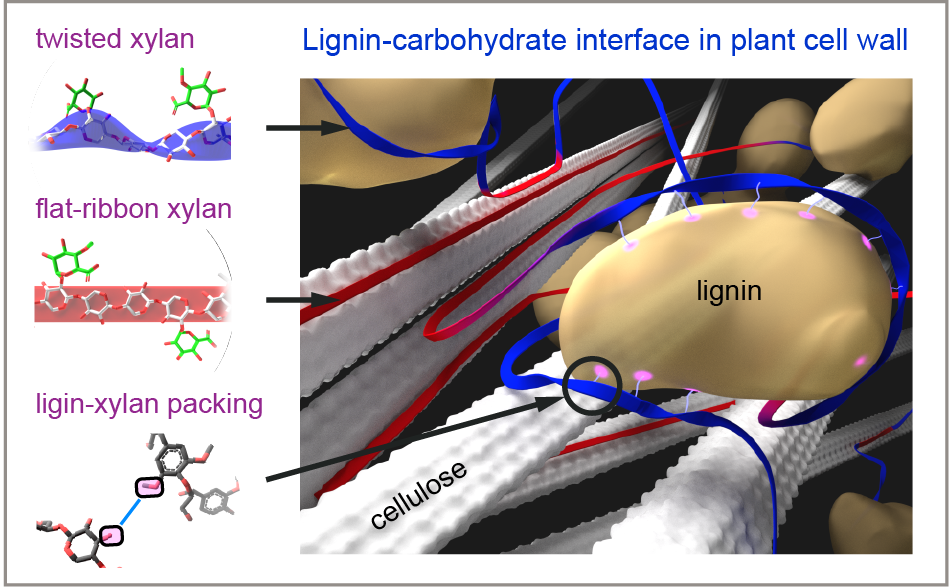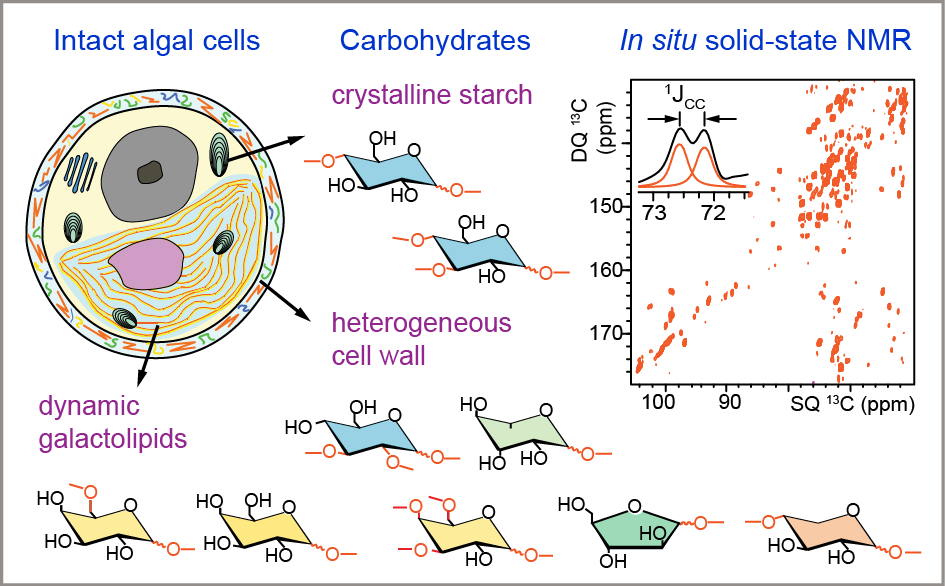Tuo Wang

Research
Biological and biomaterial solid-state NMR
For more details, please visit the website of our group: tuowanglab.com

Atomic-resolution analysis of biomolecular structure in plant biomass, fungal pathogens, and algae - Carbohydrates are essential to the life processes of living organisms but their structures are under-investigated relative to nucleic acids and proteins. We aim to establish an atomic-level toolbox, based on solid-state NMR (ssNMR), to assess the structure of carbohydrates and associated molecules (proteins, lipids, lignin, etc.) using intact and often alive cells. The insights will guide the engineering of plants and algae for energy, and the design of better drugs against microbial infections.

Biomedical: the carbohydrate armor of fungi – Invasive fungal infections (to kidneys, lungs, etc.) occur to two million patients each year, with high mortality (20-95%). Fungal cell walls are promising targets for novel antifungal drugs. We are establishing molecular-level structural models of the cell walls of Aspergillus, Candida and Rhizopus (a mold causing coinfections during COVID-19) by mapping out the mobility, hydration, and packing of carbohydrates and proteins in living cells. We identify a rigid and hydrophobic core of chitin and α-glucan, which is embedded in a soft glucan matrix and capped by a shell of protein and mannan. We are also examining how fungi remodel the cell wall to handle antifungal drugs.

Bioenergy: carbohydrate & lignin in plant biomass – Carbohydrate-lignin interactions hamper the biochemical and enzymatic processing required to produce biofuel. We are determining how the conformation of carbohydrates and the structure of lignin directly regulate their physical packing in intact stems of grass (maize), hardwood (poplar) and softwood (spruce). We reveal that xylan uses its flat-ribbon conformers to coat the surface of cellulose microfibrils and uses its twisted conformers to link lignin nanodomains. Such findings provide the structural basis for optimizing biofuel production.

Biopolymer: the understudied algae - As the basis of aquatic food chain, microalgae play crucial roles in pharmaceutical and nutraceutical industries. We are elucidating the structure of starch grains, cell walls, glycoproteins, and glycolipids in multiple algal species, such as Chlamydomonas and Chlorella, to correlate biomolecular structure with digestibility in microalgae.
Method: label-free NMR and database - NMR analysis typically requires isotope-labeling, which is impractical for large biosystems and biomedical materials that cannot be replicated in vitro. We are thus developing sensitivity-enhancing Dynamic Nuclear Polarization (DNP) method to enable high-resolution analysis of unlabeled materials. Coupling DNP with a carbohydrate NMR database (Complex Carbohydrate Magnetic Resonance Database: www.ccmrd.org) coded in my lab, we can rapidly screen the structure of molecules in microbes, photosynthetic systems, and later, human cells.
Contact / Webpage
Area(s) of Interest
Biological (Bi)
Analytical (An)
Chemical Physics (CP)
Physical (Ph)
Selected Publications
Distinct Echinocandin Responses of Candida albicans and Candida auris Cell Walls Revealed by Solid-State NMR. Widanage…Wang. Nat. Commun. 16, 6295 (2025).
Polymorphic α-glucans as structural scaffolds in Cryptococcus cell walls for chitin, capsule, and melanin: Insights from 13C and 1H solid-state NMR. Ankur…Wang, Angew. Chem. Int. Ed. e202510409 (2025).
Solid-state NMR analysis of Schizosaccharomyces pombe reveals role of α-amylase family enzymes in cell wall structure and function. Jacob…Wang*, KL Gould*. Proc Natl Acad Sci USA (2025).
Proton-detected solid-state NMR for deciphering structural polymorphism and dynamic heterogeneity of cellular carbohydrates in pathogenic fungi. Yarava…Wang. J. Am. Chem. Soc. 147, 17416-17432 (2025).
Enriched molecular view of saline wetland soil carbon by sensitivity-enhanced solid-state NMR. Zhao…Wang, J. Am. Chem. Soc. 147, 519-531 (2025).
Molecular architecture of chitin and chitosan-dominated cell walls in zygomycetous fungal pathogens by solid-state NMR. Cheng…Wang, Nat. Commun.15, 8295 (2024).
Molecular-level architecture of Chlamydomonas reinhardtii’s glycoprotein-rich cell wall. A Poulhazan… Wang*, Warschawski* and Marcotte*. Nat. Commun.15, 986 (2024).
Adaptative survival of Aspergillus fumigatus to echinocandins arises from cell wall remodeling beyond β-1,3-glucan synthesis inhibition. Dickwella…Wang, Nat. Commun.15, 6382 (2024).
Structural adaptation of fungal cell wall in hypersaline environment. Fernando…Wang, Nat. Commun.14, 7082 (2023).
Carbohydrate-aromatic interface and molecular architecture of lignocellulose, Kirui…Wang, Nat. Commun. 13, 538 (2022). Editor’s highlight.
Solid-state NMR investigations of extracellular matrices and cell walls of algae, bacteria, fungi, and plants. Ghassemi…Wang, Chem Rev. 122, 10036-10086 (2022). Supp. Cover. Invited review.
A molecular vision of fungal cell wall organization by functional genomics and solid-state NMR. Chakraborty…Wang, Nat. Commun. 12, 6346 (2021).
Identification and quantification of glycans in whole cells: architecture of microalgal polysaccharides described by solid-state NMR. Poulhazan … Wang, J. Am. Chem. Soc. 143, 46, 19374-388 (2021). Front Cover.
Lignin-polysaccharide interactions in plant secondary cell walls revealed by solid-state NMR. Kang…Wang, Nat. Commun. 10, 347 (2019).
Molecular architecture of fungal cell walls revealed by solid-state NMR. Kang…Wang, Nat. Commun. 9, 2747 (2018).
CV
B.S. (2010) Nankai University
Ph.D. (2016) Massachusetts Institute of Technology
Postdoc (2016-17) Massachusetts Inst. of Technology
Assistant Professor (2017-2021) Louisiana State Univ.
Associate Professor (2021-2022) Louisiana State Univ.
Carl H. Brubaker, Jr., Associate Professor (2022-2025) Michigan State Univ.
Carl Brubaker Professor (2025-present) Michigan State Univ.
Awards
| Year | Award | Organization |
|---|---|---|
| 2025 | AMPERE Prize for Young Investigators | The Groupement AMPERE Society |
| 2025 | Horace S. Isbell Award | ACS Carbohydrate Division |
| 2023 | Varian Young Investigator Award | 64th Experimental NMR Conference (ENC) |
| 2022 | Inaugural Carl Brubaker Professorship | Michigan State University |
| 2021 | Anatole Abragam Prize | International Society of Magnetic Resonance (ISMAR) |
| 2020 | CAREER Award | National Science Foundation |
| 2020 | CAREER Award | U.S. Department of Energy |
| 2020 | Ralph E. Powe Junior Faculty Enhancement Award | Oak Ridge Associated Universities (ORAU) |